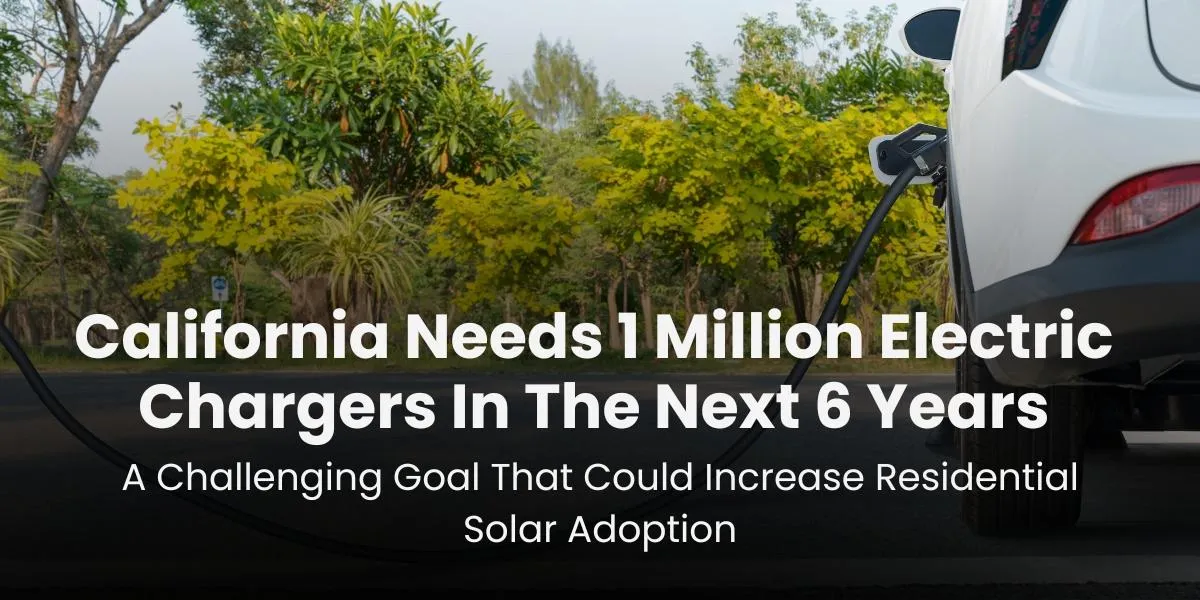Solar Industry
Latest Articles
Transparent Reporting for a Sustainable Future
Read the latest...

California Needs 1 Million Electric Chargers In The Next 6 Years- A Challenging Goal That Could Increase Residential Solar Adoption
In recent years, California has set ambitious goals for electric vehicle (EV) adoption, committing to a future where most new vehicles sold in the state are electrically powered. However, while policy aspirations abound, the practicalities of implementing the charging infrastructure necessary to support such a rapid transition raise significant concerns. As experts warn, California faces a rocky road ahead if challenges surrounding public charging are not addressed swiftly and effectively.
The Electric Vehicle Landscape in California
California’s EV Mandate and Projections
California aims to deploy approximately 1 million public chargers by the end of 2030. This ambitious goal is part of Governor Gavin Newsom's strategy, which includes having 68% of all new cars sold by 2030 be zero-emission vehicles, escalating to 100% by 2035. The key statistics underline the scale of this vision:
2030 Goal: 1 Million public chargers
2035 Goal: 2.1 Million public chargers
EV Ownership Projection: 15 Million electric cars
However, critics argue that achieving these targets could be highly unrealistic given the current infrastructure landscape.
The Current Charging Landscape
As of now, California has a significantly lower number of public chargers than required. The state had fewer than 129,000 stations operating as of late 2023, which means a dramatic sevenfold increase in infrastructure is needed to meet the projected demand. In order to achieve that goal, it is necessary to construct 129,000 new stations annually, which is over seven times the current rate, for the next seven years. After that, the speed of construction would need to further increase to meet the aim of 2.1 million chargers by 2035.
Experts in the field have voiced their doubts. Stanford professor Bruce Cain warns, “It is very unlikely that we will hit our goals. To be completely frank, the EV goals are a noble aspiration, but unrealistic.”
The Charging Infrastructure Crisis
Understanding the Scale of the Challenge
Transitioning to a robust network of chargers will require not only an increase in quantity but also significant improvements in the quality and reliability of existing infrastructure. Here are some startling statistics:
Current Fast Charger Costs: Ranges from $110,000 to $440,000 each.
Annual Charger Installation Needed: Approximately 129,000 new stations each year for the next seven years.
Barriers to Expansion
Several obstacles impede the rapid expansion of charging stations:
High Infrastructure Costs: Installation of each fast charger can be exorbitantly expensive.
Investment Requirements: Billions of dollars are needed to facilitate the buildout.
Permitting Processes: Local governments often impose lengthy and complex permitting procedures that delay the development of new chargers.
Power Grid Limitations: Upgrades to existing energy grids are necessary to support an increased load from electric vehicles.
Real Access and Reliability Issues
Drivers across the state report significant challenges in finding functioning chargers. In 2023, as many as 27% of charging stations were reported as non-operational. This creates uncertainty for potential EV buyers who rely on dependable charging for their vehicles.
A Goal Unlikely To Be Achieved That May Boost Residential Solar Adoption
The ambitious goal of installing 1 million public EV chargers by 2030 appears increasingly unlikely to be met, primarily due to the numerous challenges in infrastructure development and funding. As public charging stations remain scarce, many Californians may turn to residential solar solutions as a practical alternative. The shift towards increasingly electrified households could be prompted by the need for reliable energy sources to charge their electric vehicles, especially as residents seek independence from the unreliable public infrastructure. Homeowners who invest in solar panels can produce their own energy, ensuring they have a consistent power supply for EV charging. This trend could lead to a significant rise in residential solar adoption, positioning it as a key player in supporting California's electrification goals and addressing the gaps in public charging availability.
Learning from Successful Frameworks
Other States and Models to Emulate
While California may be lagging in infrastructure development, other states have implemented successful strategies that could serve as a guide:
Streamlined Permitting: States such as Massachusetts have effectively reduced bureaucratic hurdles to expedite the installation of charging stations.
Utility Collaborations: States that foster partnerships between utilities and local governments often see quicker infrastructure development.
Community Engagement: Involving local communities in the planning phase improves acceptance and support for the projects.
The Financial Situation: Funding the Future
The Quest for Funding
To meet the installation demands, California requires substantial financial backing from both public and private sectors. Recent estimates suggest that nationwide, $53 billion to $127 billion will need to be mobilized by 2030 to support a thriving EV market.
Federal Support: The Biden administration has allocated $5 billion to establish a fast charger network across the nation.
California's Investment: The state has already allocated $584 million through its Clean Transportation Program.
Overcoming Financial Hurdles
Addressing the electric vehicle charging infrastructure's reliability and availability necessitates not only funding but also a reassessment of the financial models currently in use:
Invest in Innovation: Encourage private investors to fund public charging developments.
Government Incentives: Heighten incentives for companies willing to invest in charging infrastructure in less affluent areas.
Future-Proofing the Charging Network
Strengthening the Power Grid
One critical step in overcoming hurdles is modernizing and expanding California’s power grid. Not only will this enable more charging points to be established, but it will also accommodate the significant energy demands of electric vehicles. As the demand for electricity continues to rise, driven by increased adoption of EVs and the shift towards renewable energy, residential solar power will become increasingly essential. Many homeowners are looking to solar solutions to meet their energy needs, especially as public charging infrastructure lags behind. By generating clean energy on-site, residents can charge their vehicles at home, reducing their dependence on public charging stations, which may be limited or unreliable.
Innovative Technologies
Embracing Smart Charging Solutions
Investments in smart charging technology can enhance the efficiency of charging stations and improve user experiences. Potential innovations include:
Smart-grid technologies that optimize energy usage.
Mobile apps that provide real-time updates on charging station availability.
The Role of Community Engagement
Listening to Consumers’ Needs
It's crucial for stakeholders to prioritize consumer experiences when planning the expansion of charging infrastructure. By surveying and actively engaging with EV owners, policymakers can pinpoint the critical areas needing attention.
Regular Feedback Loops: Establish a system to gather user feedback about charging station usability and reliability.
Community Workshops: Hold events focused on educating the public about EV benefits and garnering input on infrastructure development.
The Road Ahead
Achieving California’s ambitious electric vehicle goals will not be an easy feat. The challenges of building a robust and reliable charging network, coupled with financial constraints and bureaucratic hurdles, create a complex road ahead. However, through innovative solutions, strategic investments, and community engagement, California can still position itself as a leader in electric vehicle infrastructure. By embracing residential solar as a supplement to public charging, we can better prepare for the future demands placed on our electrical grid.
FAQs
1. What is California’s target for electric vehicle chargers by 2030?
California aims to have 1 million public chargers by the end of 2030.
2. Why are so many chargers reported as non-operational?
The infrastructure has not kept pace with the increasing number of electric vehicles, leading to reliability issues.
3. How does California's EV funding compare to other states?
California has invested $584 million into electric vehicle infrastructure, which is significantly higher than many other states.
4. What role do utilities play in the expansion of charging stations?
Utilities are critical in upgrading power grids and facilitating health and safety compliance for new installations.
5. Are there alternatives to public charging stations?
Yes, residents can install home charging solutions, which can often prove more convenient and cost-effective in the long run.
Showcase Your Product or Service
Sponsorship Package
Bronze Package: Basic Visibility
$1,000 / Month
One Sponsored Article: A featured post on the blog about your brand, product, or service (up to 600 words)
Display Ad on Website: A banner ad (300x250 px) placed on the homepage or specific blog pages for one month
Social Media Mention: One mention on Solar News Today’s social media platforms (Twitter, LinkedIn, Facebook)
Newsletter Inclusion: Your brand included in the monthly Solar News Today newsletter (with a link to your website)
Brand Logo on Website: Small logo inclusion in the "Sponsors" section of Solar News Today

Silver Package: Enhanced Engagement
$2,500 / Month
Two Sponsored Articles: Two blog posts (up to 800 words each) highlighting your brand, services, or industry insights
Premium Display Ad: A large banner ad (728x90 px) placed at the top of the homepage or specific blog posts
Social Media Spotlight: Three mentions (Twitter, LinkedIn, Facebook) featuring your brand or product
Newsletter Feature: A dedicated section in the monthly Solar News Today newsletter with a link to your website
Podcast Interview: A 10-minute interview or feature with your company representative on the Solar News Today podcast
Brand Logo and Link on Website: Prominent placement of your logo and link on the "Sponsors" section of Solar News Today

Gold Package: Premium Partnership
$4,000 / Month
Four Sponsored Articles: Four in-depth blog posts (up to 1,000 words each), covering your company, products, services, or thought leadership in the solar industry.
Exclusive Display Ad: A prime leaderboard banner ad (970x250 px) placed at the top of the homepage and blog pages for maximum exposure
Social Media Campaign: Six posts across Solar News Today’s social media platforms with targeted hashtags, including one video or live session showcasing your company or product
Newsletter Feature + Spotlight: A dedicated section in the monthly Solar News Today newsletter, along with a spotlight feature in a separate email blast sent to subscribers
Podcast Feature: A 20-minute in-depth interview or brand feature on the Solar News Today podcast
Brand Logo and Link on Website: Top-tier placement of your logo and a link on the "Sponsors" section of Solar News Today
Event Promotion: Co-branding on Solar News Today events or webinars (if applicable)
Exclusive Discounts: A limited-time offer or promotion highlighted in all digital content for your product/service


